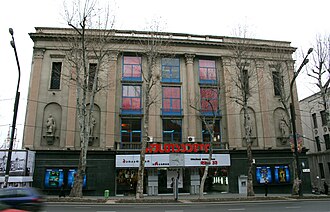Nikolai Severowe
Nikolai Pavlovich Sewerowe ( Russian Николай Павлович Северов * February 18 . Jul / 2. March 1887 greg. In Tbilisi ; † 21st February 1957 in Kiev ) was a Georgian architect and university lecturer .
Life
Severowe, son of a German teacher, attended secondary school in Wladikawkas . In 1904 he went to St. Petersburg and learned watercolor painting in the Central School for Technical Drawing of Baron Alexander von Stieglitz . In 1905 he passed the entrance examination of the St. Petersburg Institute for Civil Engineers , so that he now studied architecture there . During his studies he worked from 1907 to 1910 as an assistant to the architect E. Schretter. In 1910 he became an assistant to the academician O. Dmitrov, where he was involved in various railway building projects in Kharkov and other places from 1911 to 1912 . The Feodosia train station was his first project of his own.
After the beginning of the First World War Severowe completed his studies in 1915 and was then drafted into the army. After the October Revolution he worked as an architect in Tbilisi. In 1922 he became a lecturer at the newly founded Academy of Arts in Tbilisi . In 1935 he became chairman of the Union of Architects of the Georgian SSR . In 1939 he became an honorary member of the Academy of Architectural Sciences of the USSR . During the Second World War in 1942 he became head of the Institute for the History of Georgian Art of the Georgian Academy of Sciences .
Sewerowe planned more than 60 projects, of which more than 25 were carried out. These included hotels and holiday homes in Borjomi , Gagra and Zqaltubo . In 1921 he planned the renovation of the Museum of Georgia in Tbilisi (today the State Simon Janaschia Museum of Georgia ). In 1928 he built the state bank building. This was followed by the building of the Transcaucasian government , which was then used by the Central Committee of the Communist Party of Georgia (1929–1930). In 1935, together with Kiriak Sawriewi, he designed the Chelyuskinzy Bridge (now Queen Tamar Bridge ) over the Kura in Tbilisi. 1936–1938 he built the Rustaveli cinema with 1200 seats in Tbilisi. He examined and described many historical buildings in Georgia, particularly in Mtskheta and Kutaisi .
In 1948 Severowe left Tbilisi and settled in Kiev. He became a professor at the Kiev Institute of Construction and the Kiev Art Institute of the Ukrainian Academy of Arts , of which he became a member (until 1955, 1952–1954 Vice President). He also participated in the reconstruction. In 1954 he became a member of the CPSU .
Severowe was buried in the Lukjanivska Cemetery in Kiev.
Honor
Web links
Individual evidence
- ↑ Article Severov Nikolai Pavlovich in the Great Soviet Encyclopedia (BSE) , 3rd edition 1969–1978 (Russian)
- ↑ Severov, Nikolai Pavlovich (accessed on 11 October 2016).
- ↑ 1930, the building of the Communist Party, the architect N. Severov (accessed October 11, 2016).
- ^ Georgian Culture - Cinema (accessed October 11, 2016).
| personal data | |
|---|---|
| SURNAME | Severowe, Nikolai |
| ALTERNATIVE NAMES | Severowe, Nikolai Pavlovich (full name); Се́веров, Никола́й Па́влович (Russian) |
| BRIEF DESCRIPTION | Georgian architect and university professor |
| DATE OF BIRTH | March 2, 1887 |
| PLACE OF BIRTH | Tbilisi |
| DATE OF DEATH | February 21, 1957 |
| Place of death | Kiev |
